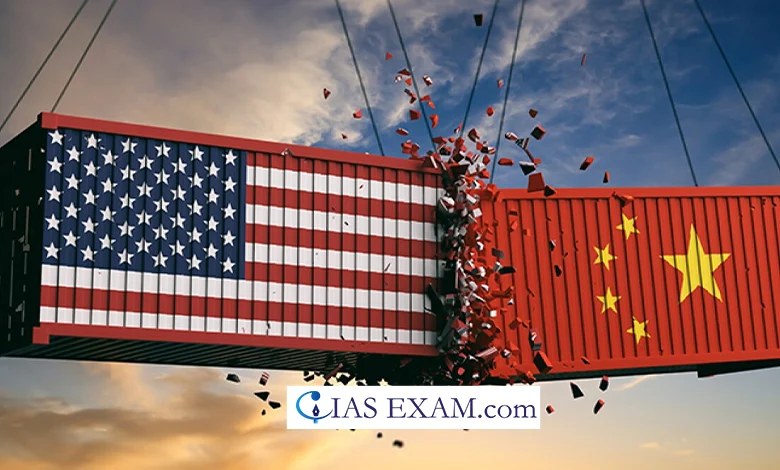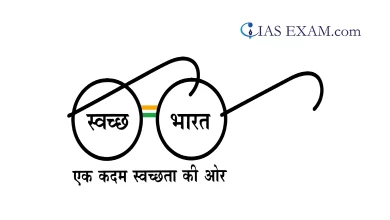What’s behind the latest US-China Trade War?
GS Paper 2 - Bilateral, Regional & Global Grouping involving India

Context
China’s burgeoning production of electric cars and other green technologies has become a flashpoint in a new US-China trade war, highlighted by the US Treasury Secretary Janet Yellen during her five-day visit to China.
According to the Paris-based International Energy Agency, China has built a substantial car industry that accounts for 60% of global electric vehicle sales. Similar dynamics exist in other industries, such as solar panels, batteries, and steel. China is now the world’s largest producer of solar cells.
US-China Trade Dispute
- The United States and China have been at odds since the last few years, when Trump imposed high tariffs on imported steel and aluminum from China, and China retaliated by placing tit-for-tat tariffs on billions of dollars in American goods.
- The IMF said that US-China trade tensions were one factor contributing to a “significantly weakened global expansion” late last year, as it reduced its global growth prediction for 2019.
- The main concern at present is that the Chinese are building up a lot of capacity in many industries across the board, including these new technology sectors, and if domestic demand does not pick up, they are going to be looking for markets outside the country.
US-China Trade and Investment Facts
- US goods and Services trade with China totalled an estimated $737.1 billion in 2018. Exports: $179.3 billion; imports: $557.9 billion; deficit: $378.6 billion
- China is currently the US’s largest goods trading partner with $659.8 billion in total (two-way) goods trade in 2018. Exports: $120.3 billion; imports: $539.5 billion; US goods trade deficit: $419.2 billion
- US FDI in China (Stock) was $107.6 billion in 2017, a 10.6% increase from 2016. US direct investment in China is led by manufacturing, wholesale trade, finance and insurance
- China FDI in the US (Stock) was $39.5 billion in 2017, down 2.3% from 2016. China’s direct investment in the US is led by manufacturing, real estate, depository institutions.
Concerns raised by USA and China
- According to China, the Biden administration pushed through various bills that gave financial assistance to clean energy and semiconductor manufacturers.
- China has also launched a protest with the World Trade Organisation (WTO), alleging that some of Biden’s incentives for electric vehicle purchases violate trade regulations.
- However, according to a 2022 analysis, China’s industrial subsidies in 2019 were twice as large (in currency terms) as US support.
- China subsidizes the manufacture of commodities with no increase in consumption by its own people.
- During the COVID-19 epidemic, the United States sponsored substantially higher consumption with many rounds of stimulus checks.
How China’s Auto Industry is posing a threat to the Indian Market?
- Market Dominance: China is dominating the domestic market and threatening to control India’s traditional export markets, which may raise concerns about the ‘Make in India’ initiative.
- Quality Concerns: The quality of car components imported from China is a key worry for vehicle safety in India. With rising stakes by Chinese merchants, the situation is projected to worsen.
- Cost Advantage: Chinese automakers enjoy a cost advantage over North American and European brands, allowing them to undercut their competitors. This cost advantage is attributable to Chinese manufacturers’ ability to create electric vehicles more effectively and economically than their Western equivalents.
- Security concerns: Chinese automakers flooding foreign markets with their autos and the potential for these vehicles to be used for espionage, data collection, or sabotage.
How can India benefit from the US-China Trade War?
- Export Opportunities: India can tap export opportunities in both the US and China, particularly in areas such as garments, agriculture, automobile, machinery, apparel, and readymade garments.
- Export Growth: India’s exports to the US increased by 11.2% in 2018, and to China by 31.4% in the same year, indicating the potential for further growth.
- Product Opportunities: India can boost exports of around 350 products to the US and China, including items like copper ores, rubber, paper/paperboard, industrial valves, vulcanized rubber, carbon or graphite electrodes, and natural honey.
- Trade Deficit Reduction: Increasing exports would help India narrow the widening trade deficit with China, which stood at USD 50.12 billion during April-February 2018-19.
Way Forward
The escalating trade tensions between the United States and China are fueled by China’s growing dominance in key green technology sectors, particularly electric vehicles. As China solidifies its position as a global leader in industries such as electric vehicles, solar panels, batteries, and steel production, the United States has ramped up its efforts to challenge China’s market dominance. With the potential for increased exports to both nations, India stands to benefit economically while also addressing its trade deficit with China. By leveraging its competitive advantages and expanding its presence in the global market for green technologies, India can seize new opportunities for growth and development.
SOURCE: The Hindu





.png)



